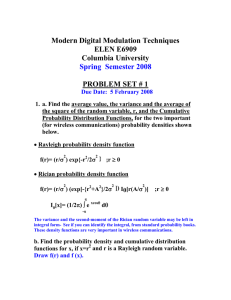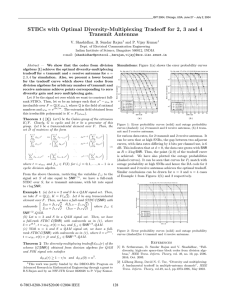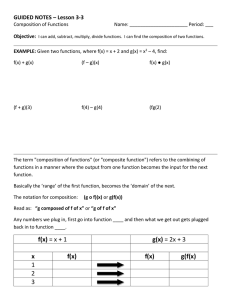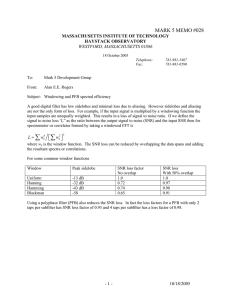Sufficient Number of Diversity Antennas for 64 QAM over Wireless
advertisement
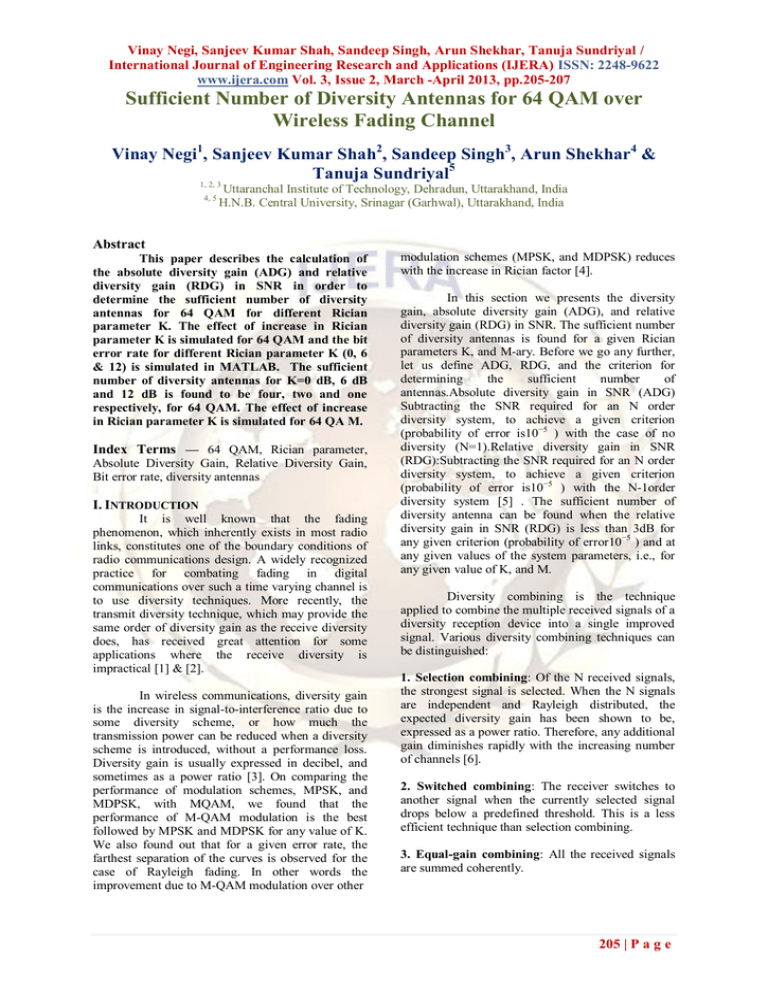
Vinay Negi, Sanjeev Kumar Shah, Sandeep Singh, Arun Shekhar, Tanuja Sundriyal / International Journal of Engineering Research and Applications (IJERA) ISSN: 2248-9622 www.ijera.com Vol. 3, Issue 2, March -April 2013, pp.205-207 Sufficient Number of Diversity Antennas for 64 QAM over Wireless Fading Channel Vinay Negi1, Sanjeev Kumar Shah2, Sandeep Singh3, Arun Shekhar4 & Tanuja Sundriyal5 1, 2, 3 4, 5 Uttaranchal Institute of Technology, Dehradun, Uttarakhand, India H.N.B. Central University, Srinagar (Garhwal), Uttarakhand, India Abstract This paper describes the calculation of the absolute diversity gain (ADG) and relative diversity gain (RDG) in SNR in order to determine the sufficient number of diversity antennas for 64 QAM for different Rician parameter K. The effect of increase in Rician parameter K is simulated for 64 QAM and the bit error rate for different Rician parameter K (0, 6 & 12) is simulated in MATLAB. The sufficient number of diversity antennas for K=0 dB, 6 dB and 12 dB is found to be four, two and one respectively, for 64 QAM. The effect of increase in Rician parameter K is simulated for 64 QA M. Index Terms — 64 QAM, Rician parameter, Absolute Diversity Gain, Relative Diversity Gain, Bit error rate, diversity antennas I. INTRODUCTION It is well known that the fading phenomenon, which inherently exists in most radio links, constitutes one of the boundary conditions of radio communications design. A widely recognized practice for combating fading in digital communications over such a time varying channel is to use diversity techniques. More recently, the transmit diversity technique, which may provide the same order of diversity gain as the receive diversity does, has received great attention for some applications where the receive diversity is impractical [1] & [2]. In wireless communications, diversity gain is the increase in signal-to-interference ratio due to some diversity scheme, or how much the transmission power can be reduced when a diversity scheme is introduced, without a performance loss. Diversity gain is usually expressed in decibel, and sometimes as a power ratio [3]. On comparing the performance of modulation schemes, MPSK, and MDPSK, with MQAM, we found that the performance of M-QAM modulation is the best followed by MPSK and MDPSK for any value of K. We also found out that for a given error rate, the farthest separation of the curves is observed for the case of Rayleigh fading. In other words the improvement due to M-QAM modulation over other modulation schemes (MPSK, and MDPSK) reduces with the increase in Rician factor [4]. In this section we presents the diversity gain, absolute diversity gain (ADG), and relative diversity gain (RDG) in SNR. The sufficient number of diversity antennas is found for a given Rician parameters K, and M-ary. Before we go any further, let us define ADG, RDG, and the criterion for determining the sufficient number of antennas.Absolute diversity gain in SNR (ADG) Subtracting the SNR required for an N order diversity system, to achieve a given criterion (probability of error is10−5 ) with the case of no diversity (N=1).Relative diversity gain in SNR (RDG):Subtracting the SNR required for an N order diversity system, to achieve a given criterion (probability of error is10−5 ) with the N-1order diversity system [5] . The sufficient number of diversity antenna can be found when the relative diversity gain in SNR (RDG) is less than 3dB for any given criterion (probability of error10−5 ) and at any given values of the system parameters, i.e., for any given value of K, and M. Diversity combining is the technique applied to combine the multiple received signals of a diversity reception device into a single improved signal. Various diversity combining techniques can be distinguished: 1. Selection combining: Of the N received signals, the strongest signal is selected. When the N signals are independent and Rayleigh distributed, the expected diversity gain has been shown to be, expressed as a power ratio. Therefore, any additional gain diminishes rapidly with the increasing number of channels [6]. 2. Switched combining: The receiver switches to another signal when the currently selected signal drops below a predefined threshold. This is a less efficient technique than selection combining. 3. Equal-gain combining: All the received signals are summed coherently. 205 | P a g e Vinay Negi, Sanjeev Kumar Shah, Sandeep Singh, Arun Shekhar, Tanuja Sundriyal / International Journal of Engineering Research and Applications (IJERA) ISSN: 2248-9622 www.ijera.com Vol. 3, Issue 2, March -April 2013, pp.205-207 4. Maximal-ratio combining: It is often used in large phased-array systems: The received signals are weighted with respect to their SNR and then summed. The resulting SNR yields where is SNR of the received signal .Sometimes more than one combining technique is used – for example, lucky imaging uses selection combining to choose (typically) the best 10% images, followed by equalgain combining of the selected images [7]. Other signal combination techniques have been designed for noise reduction and have found applications in single molecule biophysics, chemometrics among other disciplines. Table 2 Sufficient number of diversity antennas when M=64 II. Determining the sufficient number of antennas (MQAM, M=64) The ADG, and RDG in SNR for M=64, and for various values of K are obtained from the figures 1-3 and is presented in the Table 1. This table is useful in determining the sufficient number of antennas. The sufficient number of diversity antennas for various values of K is presented in Table 2. Probability of error (64 QAM) K=0, 6, 12. For all Diversity Order N=1, 2, 4, 6, 8 are as shown in figures. The ADG, and RDG in SNR for M=16, and for various values of K are obtained from the figures 1-3 and is presented in the Table 1. This table is useful in determining the sufficient number of antennas. The sufficient number of diversity antennas for various values of K is presented in Table 2. III. SIMULATED RESULTS The bit error rate for different Rician parameter K (0, 6 & 12) is simulated in MATLAB for 64 QAM as shown in fig.1, 2 & 3. Table 1 Diversity Gain in SNR (dB) when M=64 Figure 1: SEP for M-QAM over Rician fading channels for M=64 and K=0 206 | P a g e Vinay Negi, Sanjeev Kumar Shah, Sandeep Singh, Arun Shekhar, Tanuja Sundriyal / International Journal of Engineering Research and Applications (IJERA) ISSN: 2248-9622 www.ijera.com Vol. 3, Issue 2, March -April 2013, pp.205-207 [2] [3] [4] Figure 2: SEP for M-QAM over Rician fading channels for M=64 and K=6 [5] [6] [7] Channel, International Journal of Advances in Science and Technology, Vol. 3, No.1, 2011 Difference Threshold Test forM-FSK SignalingWith Reed–Solomon Coding and Diversity Combining in Rayleigh Fading Channels, IEEE TRANSACTIONS ON VEHICULAR TECHNOLOGY, VOL. 54, NO. 3, MAY 2005 Performance Analysis of Combined Transmit Selection Diversity and Receive Generalized Selection Combining in Rayleigh Fading Channels Xiaodong Cai, Member, IEEE, and Georgios B. Giannakis, Fellow, IEEE, IEEE TRANSACTIONS ON WIRELESS COMMUNICATIONS, VOL. 3, NO. 6, NOVEMBER 2004 Bit-Error Probabilities of 2 and 4DPSK with Nonselective Rayleigh Fading, Diversity Reception, and Correlated Gaussian Interference,Pooi Yuen Kam, IEEE TRANSACTIONS ON COMMUNICATIONS, VOL. 45, NO. 4, APRIL 1997 D. G. Brennan, “Linear Diversity Combining Techniques,” Proc. IEEE vol. 91, no. 2, Feb 2003. M. K. Simon and M. S. Alouini, Digital Communications over Fading Channels. John Wiley & Sons, Inc., New York, 2000. J. Sun and I. Reed, “Linear diversity analyses for M-PSK in Rician fading channels,” IEEE Trans. Commun., vol. 51, no. 11, pp. 1749-1753, Nov. 2003. Figure 3: SEP for M-QAM over Rician fading channels for M=64 and K=12 V. CONCLUSION We calculated the absolute diversity gain (ADG) and relative diversity gain (RDG) in SNR in order to determine the sufficient number of diversity antennas for a given Rician parameter K, and M-ary modulation. The sufficient number of diversity antennas for K=0 dB, 6 dB and 12 dB is found to be four, two and one respectively, for all values of M. The increase in Rician parameter K decreases the diversity gain for any value of M. This means that the diversity is not useful at higher values of the Rician parameter K. REFERENCES [1] BER Performance of Reed-Solomon Code Using M-ary FSK Modulation in AWGN 207 | P a g e

